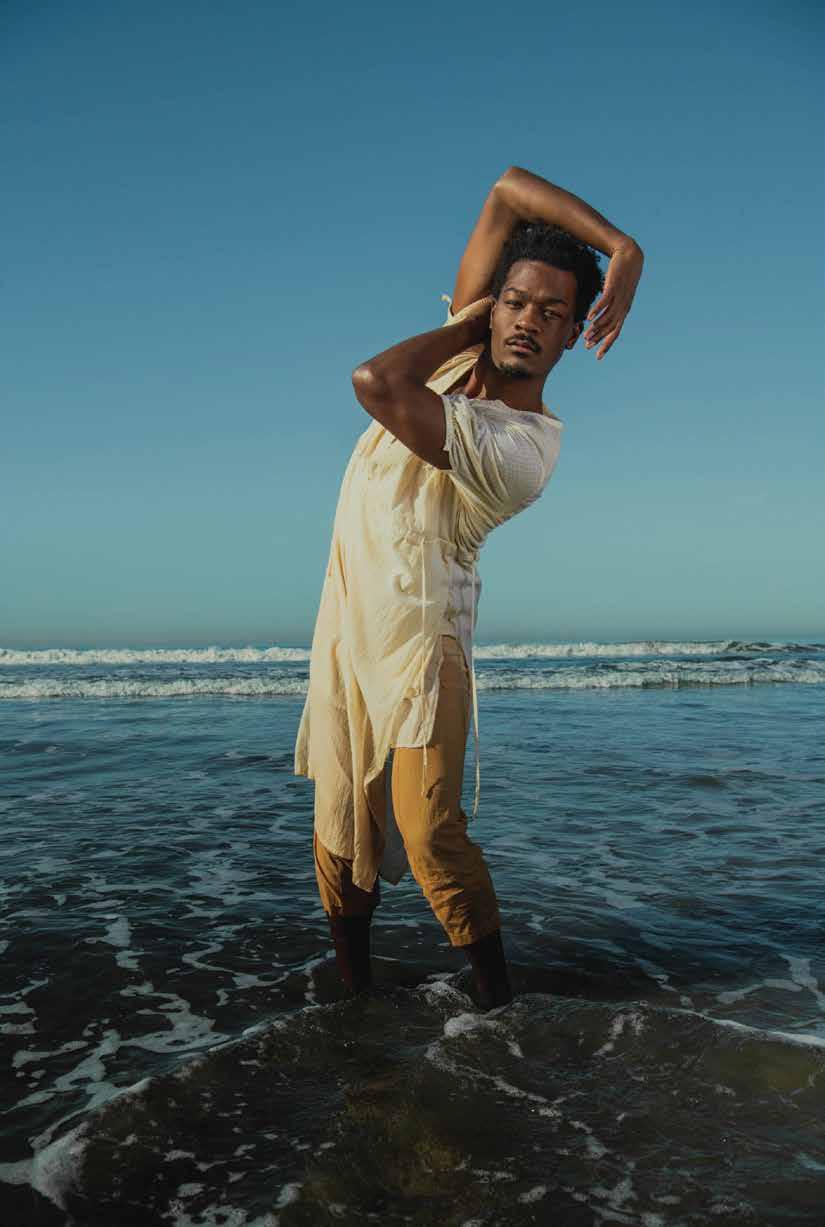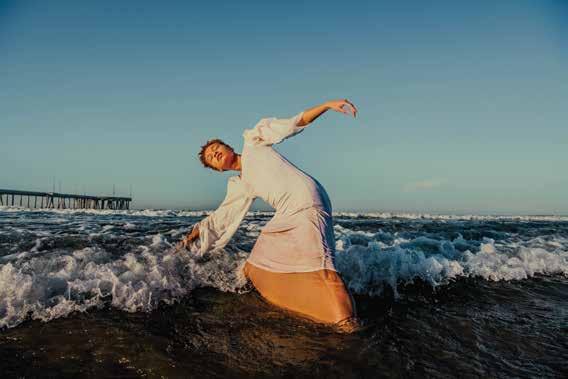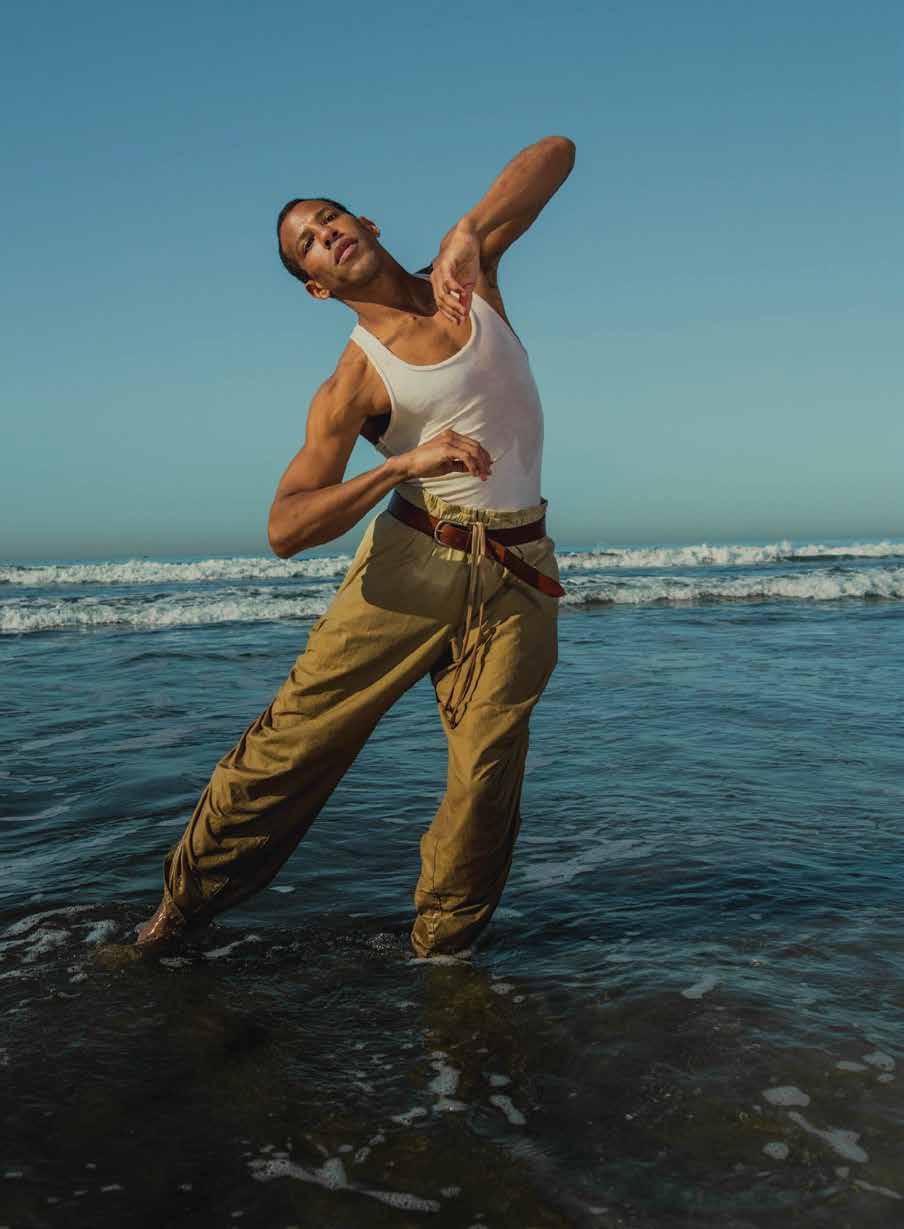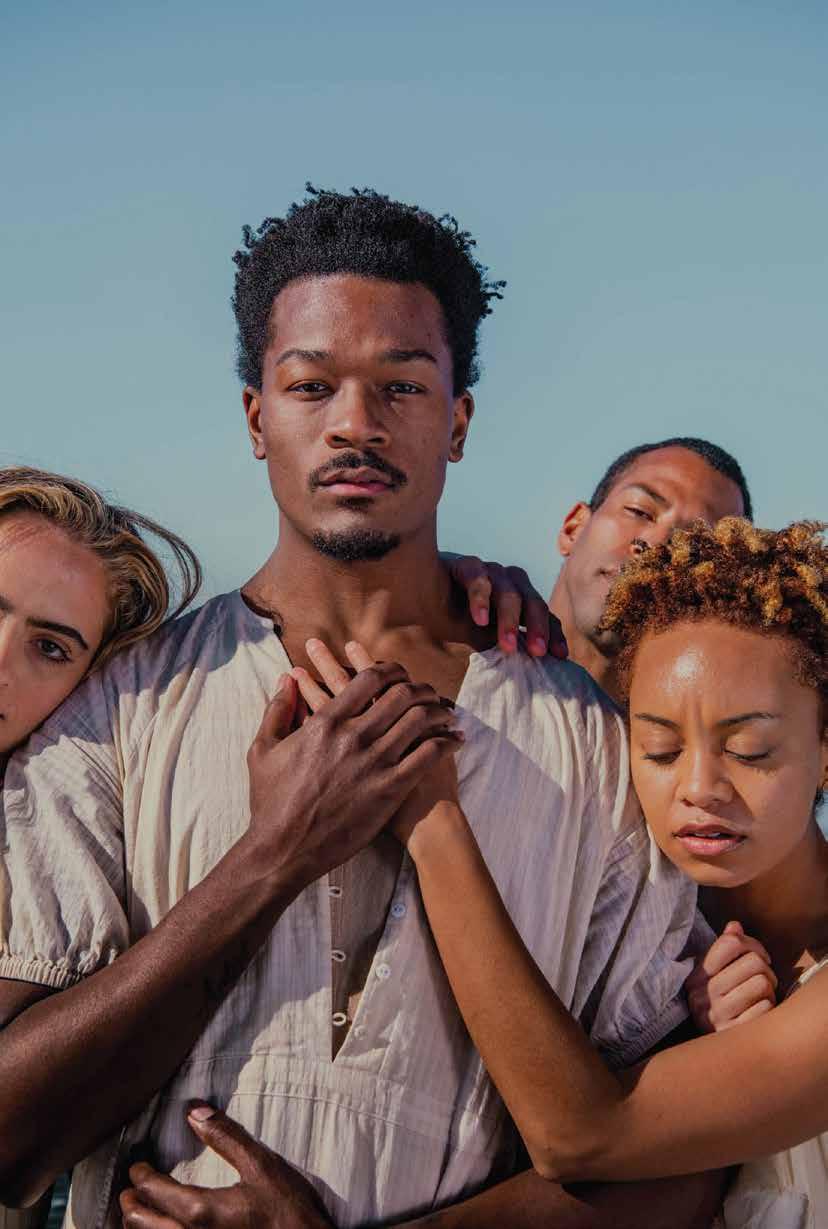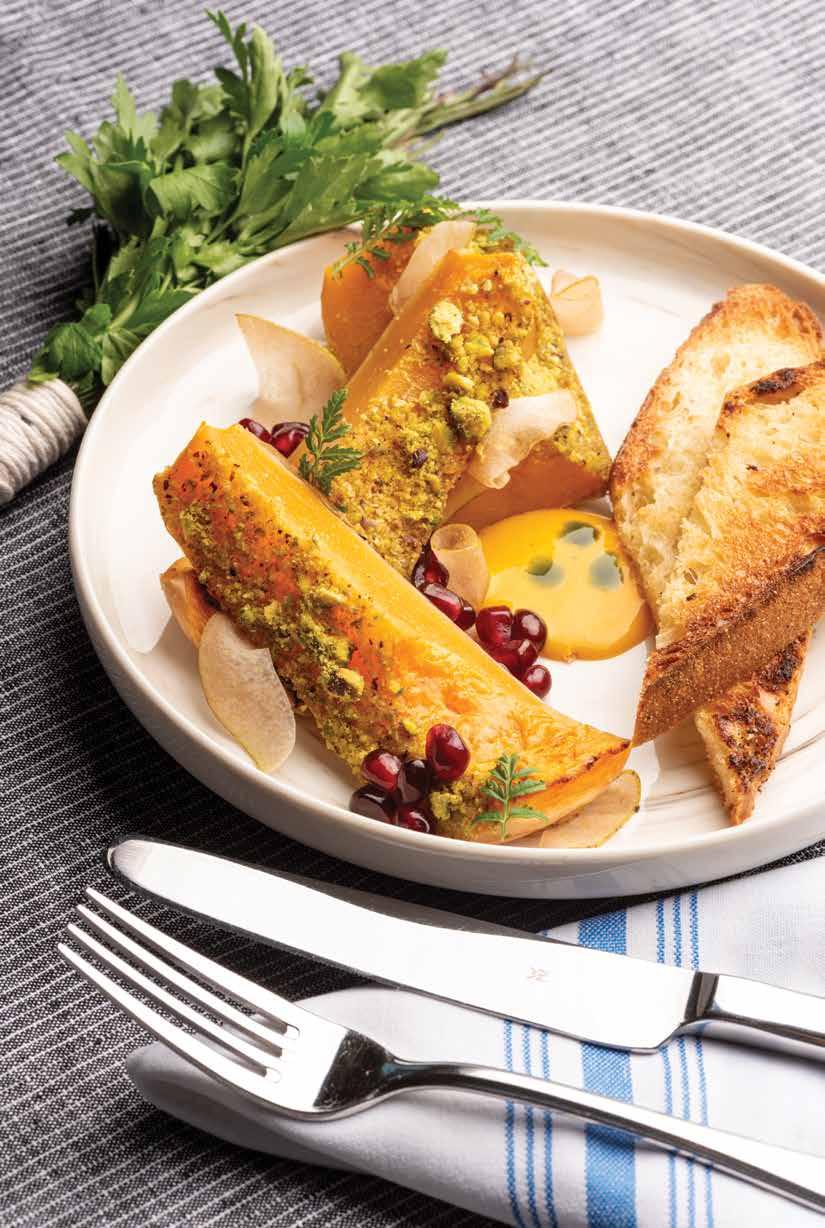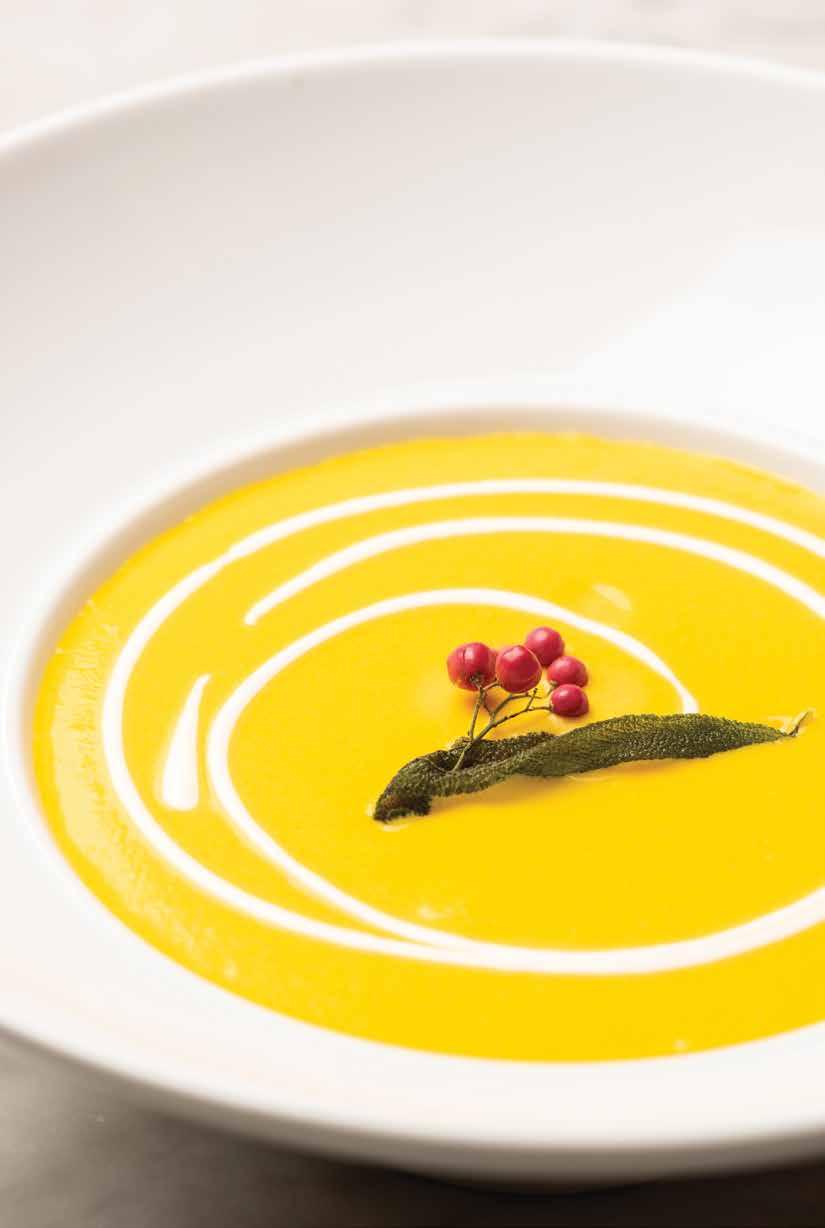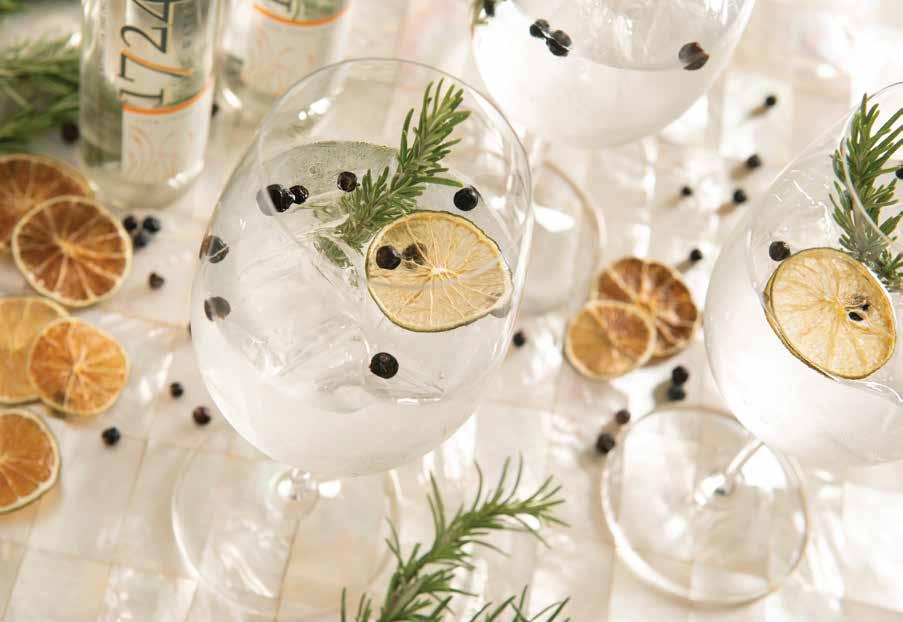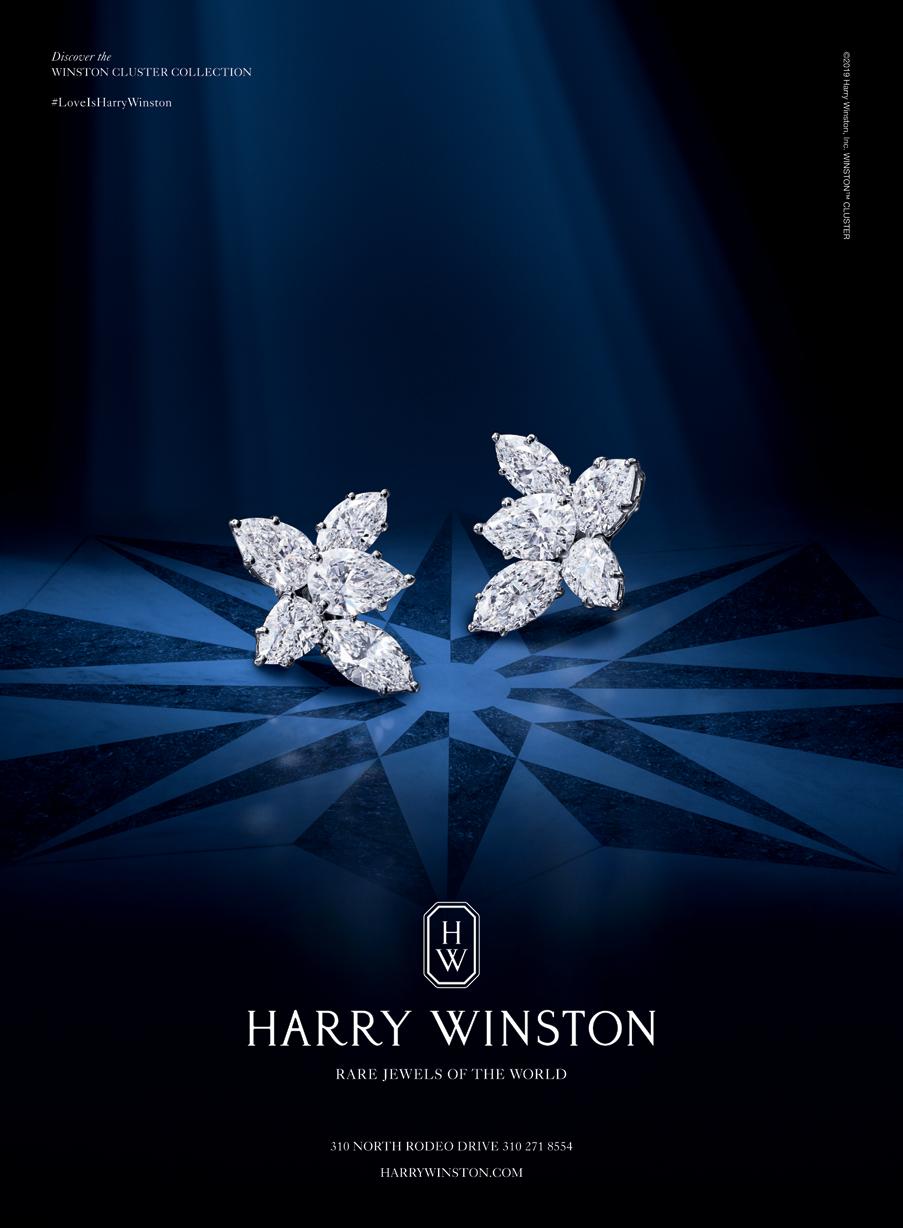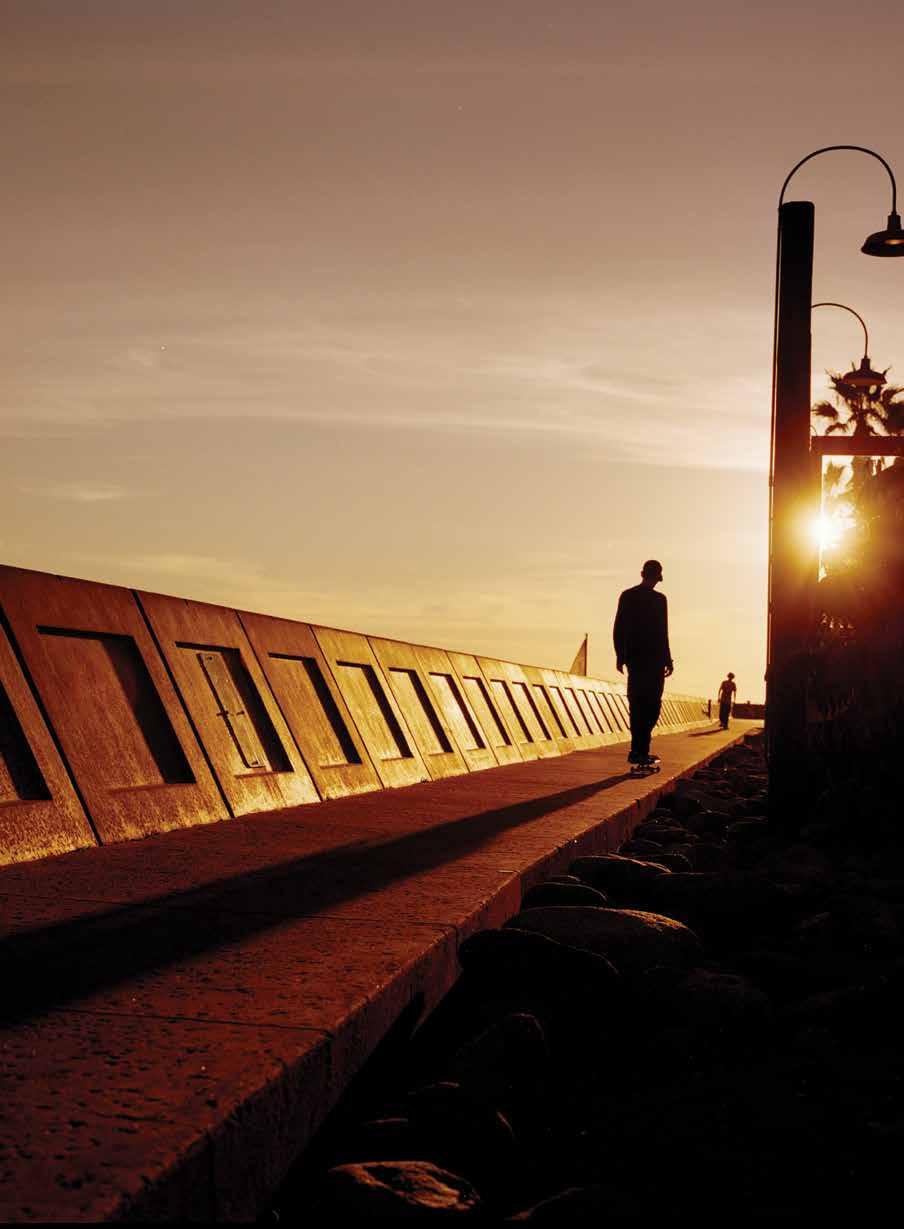 Season Three
Season Three






“When I need a break, I step outside and breathe in the sights and sounds of Santa Monica Beach, and I am immediately relaxed, energized, and inspired.”
Gemma Gray Executive Chef of Hotel Casa del MarVITTORIO LUCARIELLO EXECUTIVE CHEF, SHUTTERS ON
THE BEACH:
I have had the pleasure of working at Shutters on the Beach for over five years, and I never tire of being near the shore during sunrise or watching the sunset on the horizon. Shutters is a popular destination which means that occasionally I even get to see both light shows in one day! My children love visiting me on the Westside. Our favorite family outing is to shop on Montana Avenue. There are quaint boutiques and specialty stores from Ocean Avenue to about 20th Street, and most of the businesses are locally owned and operated.
As a chef, probably the biggest perk to working in Southern California is the year-round farm-fresh produce. I have had a chance to develop close relationships with so many dedicated farmers and ranchers. This time of year, I love the variety of colors, sizes, and flavors of heirloom squashes and pumpkins. As a result, I’m sharing some of our team’s favorite winter squash dishes in this issue of Waves. Some will also appear on our menus over the next few months.
GEMMA GRAY
EXECUTIVE CHEF, HOTEL CASA DEL MAR
For me, Santa Monica is a breath of fresh air from the hustle and bustle of Los Angeles. Every day, when I arrive to Hotel Casa del Mar, I am smiling as I walk into the kitchen, having just enjoyed the vibrant blue ocean that is Casa’s backyard. On the weekends you can find me at my neighborhood community garden, getting caught up with friends, and foraging through one of the many nearby farmers markets. Whenever I can, I take road trips up the coast to Malibu or Santa Barbara, enjoying fresh seafood while my dogs become hypnotized by the smells from the ocean.
Family is as important to me as my cooking. The moment you walk through the door, you’re family, which is also the philosophy of ETC Hotels. I have worked at Hotel Casa del Mar for over five years and take great pride not only in the food I prepare for guests, like my hamachi crudo (pictured right), but also the fact that I get to mentor culinary talent. They become like my family in that we have formed strong bonds, particularly through the recent global pandemic. Sharing our personal styles and traditions enriches what and how we serve our guests.
I cannot imagine being anything other than a chef. I really love what I do—the pace of the kitchen, the smell of fresh food, and the energy of working together as a team. In the fall and winter months, there is nothing more satisfying to me as a chef then preparing holiday events and watching groups of people enjoying them.

Hollinger
Effort of Glass
Good Form with the L.A. Dance Project
Savor the Season: Winter Squash with Shutters on the Beach’s Vittorio Lucariello
Cocktails: Inspiration from Hotel Casa del Mar’s Diego Ruiz de Porras
Skateboarder Miles Silvas in Los Angeles at golden hour, as captured by photographer Sam Muller. Read more about how skateboarding originated on the Westside of Los Angeles and how it has informed Muller’s aesthetic on page 52.


WAVES TV: THE RAINFOREST OF THE SEA
Learn how kelp forests in the Santa Monica Bay are being restored after decades of decline. Watch every episode of Waves, catch up on original stories, and encounter new seasonal content online.
waves. shuttersonthebeach. com waves. casadelmar. com
SOCIALIZE WITH SHUTTERS ON THE BEACH AND HOTEL CASA DEL MAR
Instagram @hotelcasadelmar @shuttersca
Facebook /CasadelMar /ShuttersontheBeach

CEO & PUBLISHER
Jason Cutinella
VP BRAND DEVELOPMENT
Ara Laylo
NATIONAL EDITOR
Anna Harmon
EDITORIAL DIRECTOR
Lauren McNally
EDITOR-AT-LARGE
Matthew Dekneef
ASSOCIATE EDITOR
Eunica Escalante
SENIOR PHOTOGRAPHER
John Hook
PHOTOGRAPHY EDITOR
Samantha Hook
CREATIVE SERVICES
Marc Graser VP GLOBAL CONTENT
Shannon Fujimoto CREATIVE SERVICES MANAGER
Kaitlyn Ledzian ART & PRODUCTION MANAGER
Gerard Elmore VP FILM
Romeo Lapitan FILMMAKER
Taylor Kondo FASHION MARKETING COORDINATOR
OPERATIONS
Joe V. Bock CHIEF RELATIONSHIP OFFICER
Francine Naoko Beppu VP NETWORK STRATEGY
Merri Gruesser VP GLOBAL PARTNERSHIPS & DEVELOPMENT
Gary Payne VP ACCOUNTING ADVERTISING
Mike Wiley VP SALES mike@nmgnetwork.com
Marly Graubard VP GLOBAL SALES
Published by: Nella Media Group 36 N. Hotel St., Ste. A Honolulu, HI 96817
©2021 by Nella Media Group, LLC. Contents of Waves are protected by copyright and may not be reproduced without the expressed written consent of the publisher. Waves assumes no liability for products or services advertised herein. Waves is a semiannual lifestyle publication of ETC Hotels.


Being by the ocean, the air feels clean. It gives me room to breathe.
—Irene Neuwirth
Jewelry designer Irene Neuwirth talks process, place, and pet portrait charms from her Malibu home.
“We’re such homebodies,” Irene Neuwirth tells me over Zoom from the home she shares with her boyfriend. The jewelry designer has impeccable taste, of course, so friends naturally pump her for tips about restaurants: “People are like, ‘Where’s your favorite place to eat?’ and I’m like, ‘On my rooftop!’”
Until a recent move to Point Dune in Malibu, Neuwirth lived in a home on the canals that run through Venice, California. Neuwirth could canoe right from her property. “Venice is a really special and creative mixture of people,” she says. “Being by the ocean, the air feels clean. It gives me room to breathe.” Neuwirth loves Malibu, but she misses her Venice home, which she’s renting to a friend of a friend. She is trying not to stress about the beautiful dishware she collected over the years. “Everything is very personal in that house!”
Everything is very personal with Neuwirth. She’s chatting from her new home office—an airy, quirky, bright, confident space with light beaming from vaulted ceilings onto a tigerorange couch. “It’s a lot of chaos: My dogs are flopped all over the place, there are a lot
of colored pencils and paints,” she says. She brings stones home from the store to make sketches with the actual material in front of her.
“I feel like everything I do is so from the heart, so from my creative mind. My house looks like my office which looks like our store which looks like our jewelry,” she says. “It’s always been that way, it’s the way I dressed and put things together as a kid. It’s just been an innate thing.”
Neuwirth’s origin story as a jewelry designer aligns with this sense of natural propulsion. After college in 2000, she was pursuing another big love—horseback riding—by assisting horse trainers and mucking stalls in Agoura Hills. On the side, she put together simple jewelry, stringing semi-precious stones and glass beads into necklaces and bracelets. Before the year was up, word had gotten around about her eye for color, and Barneys New York started to carry her work. Neuwirth’s distinctive, feminine designs have been worn by Emma Stone, Tracee Ellis Ross, Jennifer Lawrence, and Julianne Moore. (Neuwirth also got a significant name-drop mention in season one of HBO’s
Everything Irene Neuwirth touches turns out to be extremely beautiful and special. Take, for instance, the pearl necklace she first drew and then manifested on the following spread.



Hacks, when the main character lies to impress someone by bragging that she once attended “Irene Neuwirth’s birthday party.”)
Neuwirth still paints all her designs, and she’s involved in every part of the business, from stone selection to writing thank you letters to every person who purchases a piece. Like her work, Neuwirth insists that each letter be “very specific and very personal.” She loves correspondence, though she thinks her stationery situation could improve. “My stationery is fine, we have a beautiful logo,” she says. I can tell she’s struggling to restrain herself. “If it were up to me, I would have hand-painted everything.”
Neuwirth, in a blessed way, is cursed by her own diligence and creativity. This, she admits, is exemplified by her beloved pet portrait charms. She found an artist who uses “this old Victorian method,” which involves carving and then painting portraits onto a quartz crystal. They’ve got a threedimensional quality, which makes them even more entrancing in person. Neuwirth designed the first one with the artist “just for myself as a funny thing.” Then they printed an image of the charm onto an invitation—and someone wanted one. “Now, the conversations I have with my production team are like, ‘Do you think that this dog’s
whiskers are too funny on the right?’” They’ve done countless dogs (including Neuwirth’s three pups), countless horses (including Neuwirth’s three horses), and even a turtle and a squirrel. The portraits have become a calling card. Like much of Neuwirth’s aesthetic, it’s got the littlest touch of whimsy, but it’s mostly beautiful, adorable, careful, personal, lasting.
The pandemic, naturally, could have been a very difficult period for an ultra-fine jewelry company, but Irene Neuwirth’s company had an especially successful year. The jewelry sold extremely well online. “Things that are bold and colorful tend to translate better online in general,” Neuwirth speculates. But mostly, she credits incredibly loyal clients. And it couldn’t have hurt that, for her official portrait as Vice President, Kamala Harris wore a pair of incandescent Irene Neuwirth pearl and diamond earrings.
Neuwirth’s work shines on its own, even in a formal portrait. It’s confident, powerful, but with an undeniable sprezzatura. “Most of all, I think a lot of my jewelry is not overdesigned,” she says. “It’s really fun, classic, and simple jewelry, but it has a lot of flavor.”
Neuwirth’s company has thrived during the pandemic, which she credits in part to its bold and colorful aesthetic, but mostly to its loyal customers.

NEUWIRTH’S WESTSIDE RECOMMENDATIONS

“Capo has long been my favorite restaurant in L.A. They turned their parking into an outdoor patio—it’s magical and so welcoming, plus they love dogs! I go there with Ernie. (He’s the best behaved of the bunch).”

“Capitol in the Brentwood Country Mart has the most gorgeous edit.”
*You can also find an Irene Neuwirth shop-in-shop here

“Lily’s in Malibu is perfect for a breakfast burrito if you drive up the coast.”

“I love the ocean so much. It never gets old to just walk the beach in Santa Monica and put your feet in the water.”

Gerry Rodrigues spent decades swimming and competing in the open ocean before founding Tower 26 to help athletes prepare for all elements of a triathlon.
The sky is covered with a blanket of clouds on a Wednesday morning at Santa Monica Beach. I was told to arrive at 6 a.m. promptly, and when I do, I easily spot the large group I’m there to meet near lifeguard tower 26, which is about a mile south of the pier.
Dressed in swimwear, goggles, and swim caps, the 75 or so people of different ages and sizes are participants in a triathlon training program, aptly named Tower 26, that meets for beach swims here on Wednesdays from May through October. Swim coach and founder of Tower 26, Gerry Rodrigues, addresses the group loudly over the sound of the ocean and excited chatter. At 59 years old, he stands confidently in front of the crowd wearing a zipped-up hoodie and shorts. He has a voice that demands attention, so everyone quiets down and turns to listen.
Rodrigues learned to swim at the age of 7 in Trinidad, where he grew up. “According to my father, I’ve been asking him since I was 3 years old to learn to swim,” Rodrigues told me earlier. “Finally, after four years of that, I bothered him too much that he decided when I was 7 to take me for swimming lessons at the
local YMCA, and then there was no turning back. I’ve been swimming for 50 years.”
He moved to the United States in 1980 at the age of 16 to further his swim training, which increased his exposure to other athletes and access to better facilities. Throughout his career, he won more than 100 open-water races, and he is a U.S. and World Masters Champion for pool and open water. He started coaching while he was a collegiate swimmer at Pepperdine in the ’80s, and he never stopped.
In 2010, he founded Tower 26 when he saw a need for scalable specialty coaching for triathletes. Now, the organization coaches around 1,000 people per month. He’s been exclusively training triathletes t he past 10 years, and he leads the Tower 26 swim program.
“The biggest fear or challenge for triathletes is the swim,” Rodrigues tells me. “Although it’s the shortest segment of the race—the swim takes anywhere between 10 percent to 18 percent of the time of the entire race—it accounts for the highest anxiety amongst athletes participating.”



The anxiety is caused by the vast differences between swimming in the ocean versus the pool. There are no lane lines to assist with staying on track, and there’s no place to stop to rest when exhaustion or panic settles in.
Tower 26 teaches members how to manage swimming in the ocean when there are a couple thousand people swimming the same course, how to sight on the ocean to swim straight, and how to make a turn at a buoy where there are many others doing the same. Training and coaching only happen in the pool until trainees learn the necessary skills to swim in open water—they must be able to swim 1 mile continuously in under 36 minutes before they can join beach swims.
“Gerry is amazing,” says Jim Lubinksi, who oversees Tower 26’s swim, bike, run triathlon division and coaches athletes one on one.
“Not only is he a coach, but he has also been an athlete, so he can walk the walk. He has that real-world experience that he uses in his coaching,” Lubinski continues, as the crowd moves toward the water to begin their 15-minute warm-up to a buoy and back. “He pays attention to every little detail, and because of that, it’s helped me to become a better coach and to pay attention to detail and all those little things.”
“I’m sort of one of these lucky people in the world who was probably just born to do what they do,” says Rodrigues. “From that eager 7-year-old, the eagerness hasn’t diminished. I enjoy—100 percent—teaching, whether I’m coaching an Olympian or coaching somebody who’s there for their very first time.”
TIPS FOR OPEN-OCEAN SWIMMING
1. Safety is always first. You need to be comfortable, and you need to know how to manage possible conditions.
2. Know the wind, surf height, surf power and water temperature. Wind can create chop, and extreme temperatures and big surf will all increase difficulty.
3. Find a coach or group like Tower 26 that can give you instruction, so when you do go into the ocean to swim, you are safe.
EXPERT TIP : Even if the surf is small, note if it’s breaking in shallow water because of low tide, and if so, be mindful when swimming to shore by looking under your armpit or turning to check for any surf coming in.
Before the swimmers head out for their 15-minute warmup and a series of practice swims, Rodrigues gives a safety talk. “We have pretty good conditions this morning, other than it being a little overcast, visibility is going to be a little bit challenging,” he says.

There’s more to the landmark Santa Monica Pier than meets the eye.
It’s September 9, 1909. A boisterous parade flows from Santa Monica City Hall to the beach, where foot and swimming races are accompanied by live music. A tableau vivant depicts Queen Santa Monica defeating the great Rex Neptune. A naval flotilla dots the bay, anchored for just this occasion, and fireworks dazzle crowds by nightfall. It is a day of city-wide celebration—all for a brandnew sewage line running the length of a concrete pier.
It’s hard to imagine that the most Instagrammed location in Los Angeles, according to 2018 to 2019 geotag numbers, had such origins. Yet that humble beginning is exactly what transforms the Santa Monica Pier into something more than meets the eye. Its history is checkered with iconic characters, wild acts of nature, and even a dramatic political campaign worthy of its own play.
“The history of the pier is based upon the contributions of people who have made it special over the years, and I love to tell those stories,” explains James Harris, interim executive director of the Santa Monica Pier Corporation and author of Santa Monica Pier,
A Century on the Last Great Pleasure Pier “Otherwise, this would just be a bunch of planks hanging over the ocean.”
Originally built to solve the city’s growing sewage problem, the pier’s primary function was to funnel waste 1,600 feet from a treatment plant at its eastern end out into the ocean, a service that ended by 1928. But what people were really celebrating on that day in 1909, Harris points out, was the fact that the pier was only the second in the world, preceded only by one in Atlantic City, to be made entirely out of concrete. “It was considered an engineering marvel for its time,” he says.
Harris’s own history with the pier began in 1989, when he started working as a bartender at the Boathouse Restaurant (where Bubba Gump Shrimp Co. stands today). He became intrigued by stories told by “old timers,” as he calls them, pier regulars who weren’t tourists and would share memories of how the area used to be. It was through them that Harris learned of a colorful crew of citizens who banded together in 1972 to save the pier from destruction. He later detailed that story in


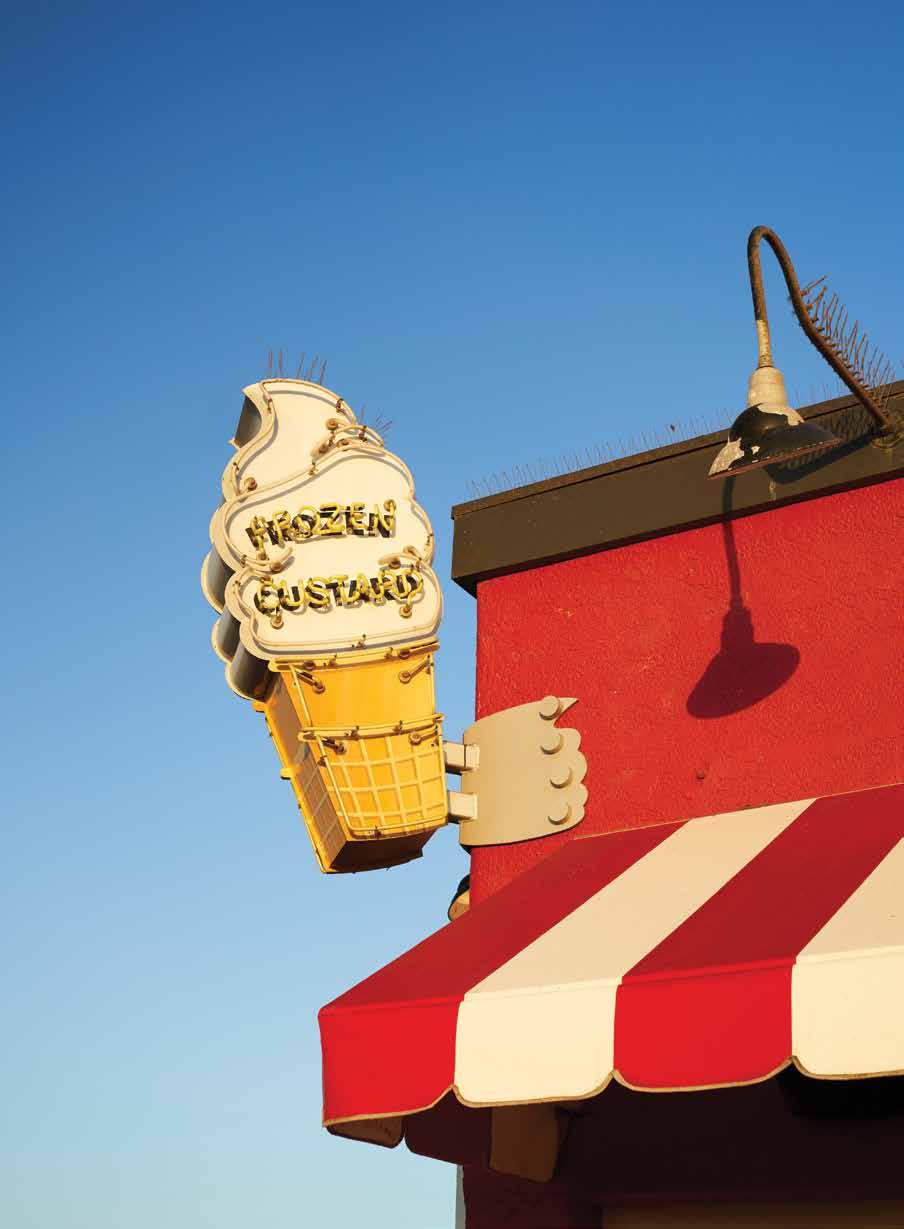
his play, “SAVE THE PIER!” which recounts when the Santa Monica City Council approved plans for a developer to tear down the pier and create a manmade, resort-filled island. The community fought back, and the pier was saved.
Harris’ interest in the pier grew as he was promoted to general manager of the Boathouse and eventually became the weekend activities coordinator for the Santa Monica Pier Restoration Corporation (as it was known in 2003). In addition to writing the pier’s official history book, he created docent-led tours. Most recently, those tours have evolved into Secret Stories, an app that brings the pier’s history to life and allows users to immerse themselves in the story of how a basic public utility grew to welcome more than 10 million visitors a year. Its puzzles, riddles, and clues unlock lesserknown elements and characters of the pier’s century-long identity.
Take Captain Olaf C. Olsen, a Norwegian immigrant who settled in Santa Monica in 1925. Olsen was a beloved regular of the pier,
which had quickly become a local fishing hub, and he frequently operated barges, dayboats, and water taxis from it. Fearing that commercial fishing would wipe out the local ecosystem, he fought to ban net fishing in the bay, a statute which continues to this day. His likeness inspired another well-known sailor: the spinach-loving Popeye created by cartoonist and Santa Monica resident E.C Segar. One look at Olsen’s photo in the Secret Stories app, and it’s impossible to mistake the resemblance.
While the pier’s celebrated cement blocks were replaced with wooden piles due to rust in 1919, public enthusiasm only increased over its first decade. The evolution from fishing community to worldfamous amusement pier can be credited to entrepreneur Charles I.D. Looff, a legendary wood carver who built the wooden carousel at Coney Island and crafted more than 40 carousels in his lifetime. He leased the land immediately south of the pier and built what would become the Looff Pleasure Pier—an addition to the original—in 1916. Just one year later, he had developed it to include



the Hippodrome carousel building (now registered as a National Historic Landmark), the Blue Streak Racer rollercoaster, the Bowling and Billiards Building, a fun house, a picnic pavilion, and other thrill rides like the Whip and the Aeroscope.
After Looff’s death in 1918, the amusement side of the pier changed ownership several times, finally closing its gates in the 1930s. The pier faded into the background. It wasn’t until the 1970s that local interest in the landmark resurfaced, as recounted in Harris’s play.
Then, in 1983, a storm sparked by El Niño took out the entire western half of the pier.
“That’s when the reimagination began,” Harris says. With revitalized city support, Pacific Park opened in 1996. Soon followed the aquarium, the solar-powered Pacific Wheel Ferris wheel, a trapeze school, and other games and restaurants.
While the pier now has a modern feel, its heavy nostalgic roots haven’t been erased. “We still have pigeons running around and sand worked into the buttons. We’re a little gritty, as we like to say,” says Nathan
Smithson, Director of Marketing and Business Development for Pacific Park.
“But that’s what makes the pier interesting. There are so many unique things that have been invented at the pier or near it … beach volleyball, Popeye the sailor man. So, for anyone looking for that authentic California experience, know that it can be had here.”


We think of ritual as being something that we all need.
—Morgan McLachlan
For distiller and Amass founder Morgan McLachlan, the incredible natural world of Los Angeles serves as botanical inspiration.
When Morgan McLachlan moved to Los Angeles in 2007, she discovered its fragrance. Not of an anonymous metropolis, but of the jasmine that permeates the city in the springtime, elderflowers blossoming in Elysian Park, and the wild sages and oaks in the hills. She acquainted herself with the plants of her new home, from the citrus of the region to the California bay tree in her backyard. With the former, she distilled the first vodka made from clementine, and the latter she featured in the dry gin of her company, Amass.
“I definitely didn’t wake up one morning when I was a little girl and decide to become a distiller,” says McLachlan. But growing up in the Pacific Northwest, she developed a love for the plants around her. She spent
summers on Vancouver Island with her grandparents, where “you’ll find coniferous trees in the temperate rainforest, from cedars to spruces to Douglas firs,” she says. “And then, because of the island’s mild climate, you’ll also find botanicals more often associated with a Mediterranean climate–lemons, sumac, sorrel, just to name a few.”
That love for plants led her to found Amass in 2018, producing spirits and then personal care products intended to celebrate botanicals and infuse them into our daily lives. The company even employs an ethnobotanist whose expertise is plants used for medicinal purposes. According to McLachlan, Amass is a botanical company, with botanicals being the through-line that connects the spirits and personal care


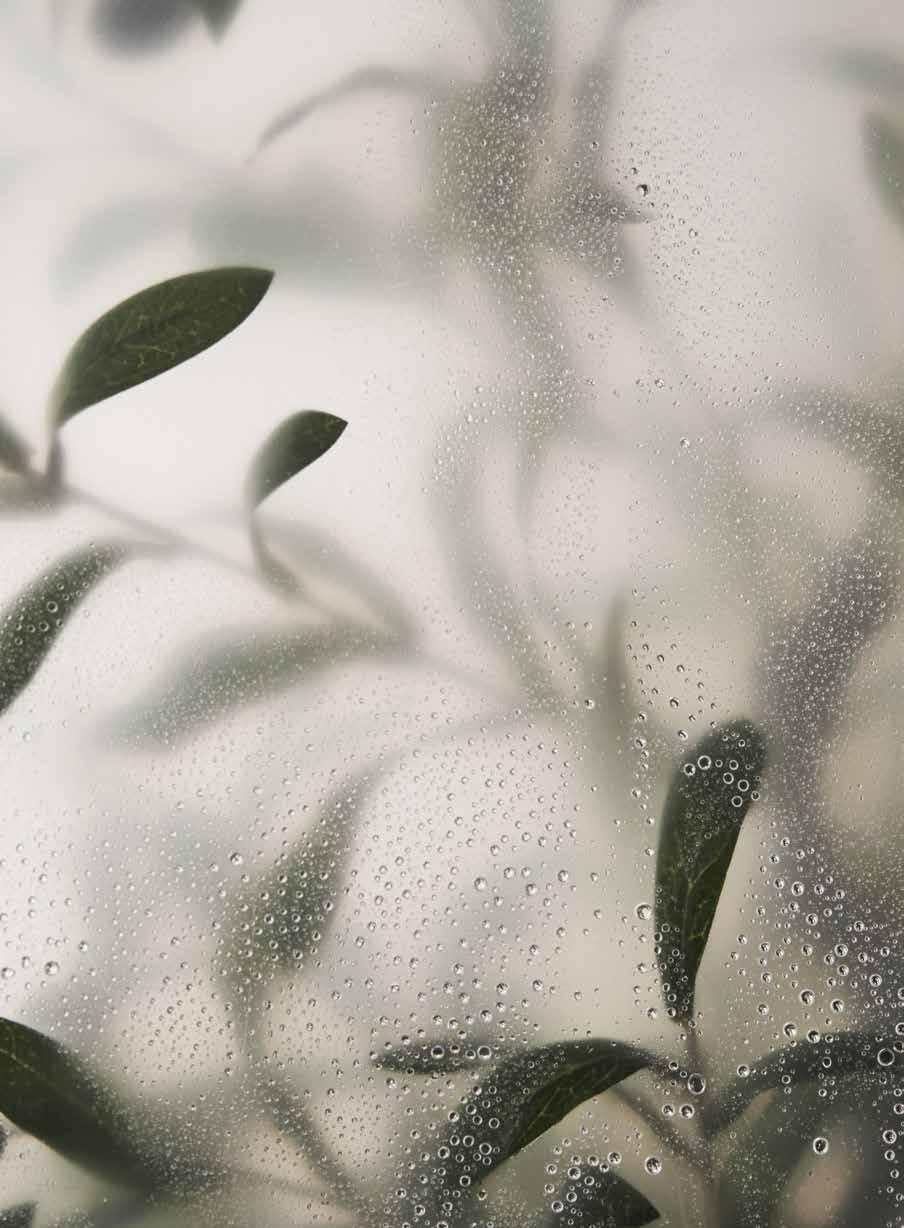
products. “It’s really about celebrating and working with the power of plants for everyday things that we consume and use,” she says.
Amass’ first spirit was the aforementioned gin with 29 botanicals to capture the spirit of L.A. (It is even distilled downtown.) “I really am inspired by Los Angeles because there are incredible indigenous plants that grow here and then also all these non-indigenous ones that are important in history—like the valley [of Southern California] that was all citrus groves up until not too long ago,” she says. “It’s really a wild place.”
Her own backyard tree still supplies the bay leaves for the company’s dry gin, which doesn’t taste like the usual juniper-forward gins—it’s more complex, suffused with coriander and cardamom and fresh citrus alongside the juniper. “What’s the point in making a new gin if you’re using those 10 botanicals that everyone’s been using for 200 years?” McLachlan says. “Why not explore other botanicals and see what they can do?”
Part of what drives her exploration is to break out of tradition and approach spirits and fragrances in fresh ways, and another part is the pursuit of biodiversity. The botanicals she uses aren’t limited to Southern Californian sources: She recently created a non-alcoholic spirit, Riverine, that is more of a tribute to the natural world of her childhood, evoking pine trees with juniper
and brightened with sorrel and sumac. And in the personal-care realm, the Four Thieves fragrance, with botanicals including clove and rosemary, is loosely based on a formula that a band of thieves used to protect themselves against the bubonic plague in medieval Europe, which she first heard of when she was researching early modern European history in college.
The culture around botanicals fascinates McLachlan as much as their functionality. While working as a research assistant in the Czech Republic for an academic writing a book about the cultural memory of the country, she started noticing very regional spirits. In the Czech Republic it might be schnapps, in Mexico mezcal, in Scotland scotch. “I became interested in the history of alcohol in relation to humanity—how we’ve co-evolved with celebrational beverages that are mood-altering and the cultural practices around making and consuming alcohol.”
Amass’ products provide ways to mark our days with botanicals. “We think of our drinks as being conduits for social rituals and our personal-care items as conduits for more personal rituals,” she says. “We think of ritual as being something that we all need, but in the modern, secular society, we don’t really have the language for.” Amass hopes to be part of new language, one that draws on the traditions carried in the plants and scents of the natural world.
People sometimes ask McLachlan how to start learning about botanicals. “You might as well ask to learn about Planet Earth,” she says. “It’s like, what part? There’s the cultural aspects, the regional aspects, there’s decorative plants, medicinal plants, culinary plants, and so on.”



For all its newfound fame, skateboarding still shines bright in its birthplace—and has never looked better than it does in Sam Muller’s photographs.
Pumping up a towering concrete ramp at the Olympic skatepark in Tokyo, Australia’s Poppy Star Olsen readied herself for airtime. For her chosen mode of lift-off, a trick called a boneless, she reached down and grabbed the rail of her board, then planted her front foot on the ramp’s coping to boost herself into the sky.
Although it probably went unnoticed by most viewers in the split second between Olsen’s launch and smooth landing, her trick showcased a significant detail that connected skateboarding’s debut at the Olympics to its humble origins in Santa Monica, a.k.a. Dogtown. The foot that vaulted Olsen’s boneless was clad in the same canvas-andrubber model of Vans shoe that Dogtown’s famed Z-Boys wore to protect their feet from the unforgiving asphalt.
Skateboarding originated in California in the late 1960s, with surfers killing time when the waves were low. They fastened rollerskate wheels to planks and started cruising the sidewalks and streets in Santa Monica and Venice. The famous Z-Boys got their name from Jeff Ho’s Zephyr Surf Shop, their hangout spot in Dogtown in the early 1970s and eventual sponsor. To this day, many skaters— from those at the Olympics representing Australia’s Southern Cross to those under Japan’s red sun—live in Southern California for its weather, skate spots, and concentration of skateboard companies.
An enduring hotspot of talent, Los Angeles is also the hub of the skate industry’s best photographers. Few shine as brightly as Sam Muller, who grew up in L.A. and got



his start photographing for TransWorld Skateboarding. Known for artfully pairing the unique movements of his skater-subjects with the surrounding architecture and light, Muller captures far more than the brute athleticism of the so-called sport. “If I can, I place the skater on a clean background like the sky or a blank wall so their form can tell the story of the trick without obstruction,” says Muller. As a regular photographer for the Dickie’s, Vans, and Adidas skateboarding teams, he gets to tell the visual stories of highlevel—and often hair-raising—skate tricks. “I want to make the trick look as dangerous and impressive as it is in reality,” he says, “so I try to emphasize the steepness of handrails or banks, the length of gaps or the height of drops the skateboarder is taking.”
Muller’s approach may sound highly calculated, but it’s largely intuitive. “One of the most exciting things about skateboard photography for me is the element of the unknown,” he says. “Almost every time I get to a location to shoot skateboarding, it’s my first time there, so I try to follow my instincts as soon as I arrive.” This spontaneous mindset invokes the original spirit of skateboarding; in contests, the Z-Boys bucked technical prowess for impromptu displays of low, surf-style carves. Perhaps Muller’s greatest skill is his ability to capture the confluence of these styles, freezing cutting-edge maneuvers in their most finessed forms and within the full context of light, line, and color, where they all hang together for a split second before the rider rolls away.
is


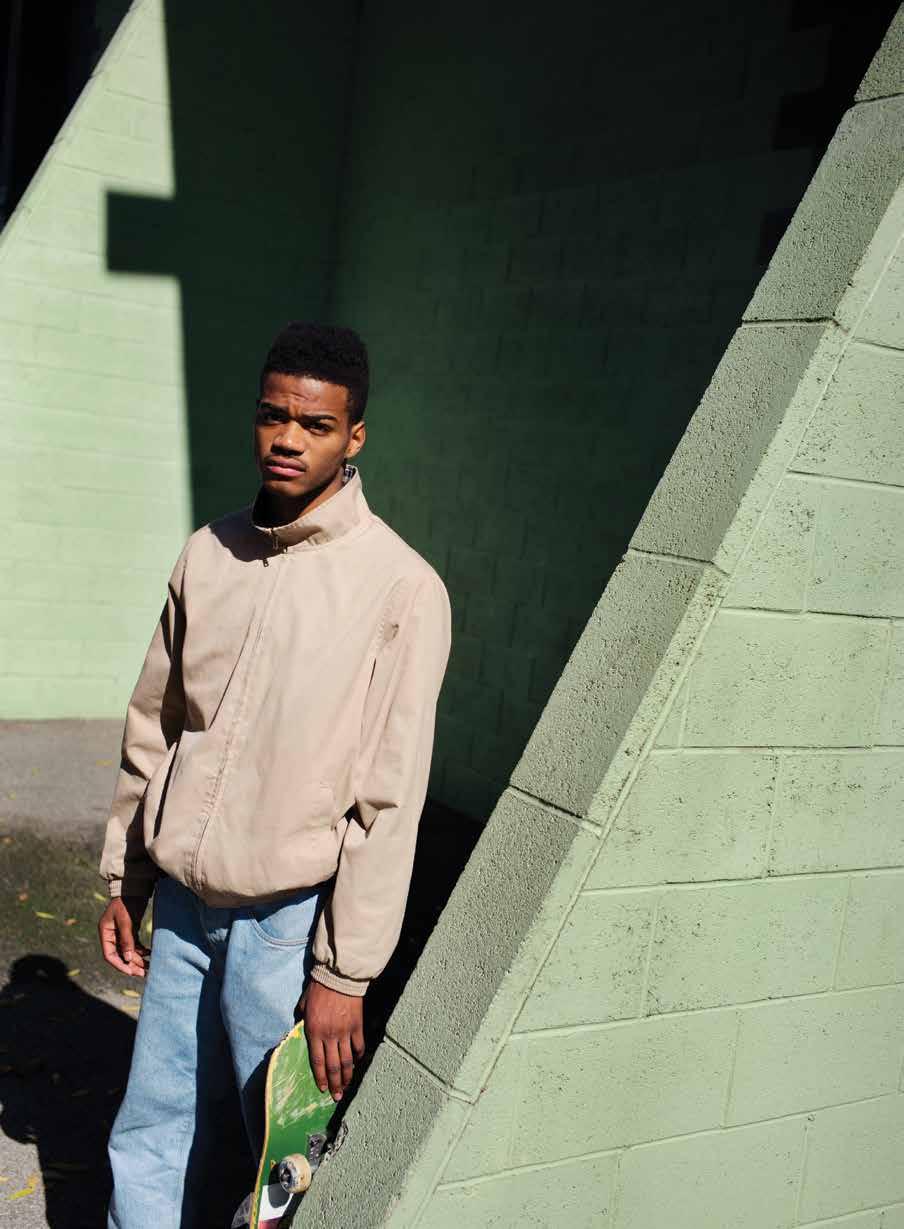





At some point , you realize this is what you’re meant to do. You settle into it.
– Gard Hollinger
Tina Tangalakis and Chris Lakey turned their shared passion for collecting art into the vibrant consulting business So Much Art.
In 2009, Tina Tangalakis was working in the fashion industry in Hohoe, Ghana when she decided to team up with local entrepreneurs and seamstresses to create Della, a fashion line designed to provide jobs and training to members of the community. “During that time, I was very much entrenched in the culture, and not just the culture, but also the arts that are coming from there,” she said from her Los Angeles home in Leimert Park, where paintings including “The Potter” by Barry Yusufu hang on the walls. “And I saw how there was a very rich, deeply underrepresented artistic movement, not just in Ghana, but other countries and within other communities as well.”
Though fashion was Tangalakis’s initial medium for interfacing with African designers and artists, she realized that art consulting would require similar skills to those she developed working in fashion— marketing, building client relationships, an artistic sensibility. “It was pretty seamless. Going from fashion in Ghana to art in Ghana, it really tied together my passions, and I think an ethos that I believed in,” she said.
Chris Lakey, Tangalakis’s husband, follows the careers of artists for a living, as well as a senior vice president of creative synch at Kobalt Music Group. For a decade, Lakey and Tangalakis developed their overlapping interests by building their personal art collection. When Tangalakis decided she wanted to take it further, the two merged their talents to create So Much Art, an art consulting business with a focus on Black artists, women artists, and artists from communities underrepresented in the mainstream art world.
Tangalakis and Lakey, however, have distinctly different tastes. Tangalakis gravitates to figurative art and Lakey to street art, which overlaps with his love of ’90s hip-hop music, its sonic parallel. “I call it ‘art living in the wild,’” Lakey said. “I like that the city can be the canvas for artists, you know, whether it’s legal murals or graffiti culture.”
Their aesthetic divergences allow the couple to understand the specific tastes of clients spread from New York to London. “We want to cater to their needs, but they also rely on us





to expand their purview into the art world,” Lakey said. “So they may have a certain style of art that they’re just very used to collecting. But we love when we get to introduce them to new artists or new regions.”
The artists Lakey and Tangalakis have worked with include Chiderah Bosah, a Nigerian painter whose colorful, monochromatic canvases serve as the perfect backdrop for his striking Black figures, and Uzo Njoku, a New York-based artist who works across mediums using oil paint, acrylic, and elements of collage. The talent and diversity of styles the couple represent through So Much Art demonstrates their taste and their passion for discovering and following artists. “We stand behind things that we love, aesthetics that we love, and artists that we love,” Tangalakis said. “I focused a lot on building an aesthetic and a brand that I felt like both artists and collectors would trust.”
In 2020, police shootings set against the backdrop of a deadly pandemic affected the way some collectors approached buying art, aligning them with the priorities of So
Much Art. “A lot of art collectors are looking at their walls, and maybe they had quoteunquote ‘traditional fine art,’” Lakey said. “And they’re reaching out and seeking Black artists, LGBTQIA+ artists, artists that usually wouldn’t be on walls in certain museums or in certain galleries.”
The couple’s collecting and expansion into consulting has bestowed Tangalakis and Lakey with a community of artists, clients, and design contacts. “Since we’re not tied to just one gallery, there’s not just one artist that we represent, which allows us the freedom of really building relationships with all types of artists,” Tangalakis said. “As long as we like their work and see their passion and their passion aligns with ours, they’re artists that we can stand behind, which is exciting.”
“We want to see the history of their art, the growth of their art, we silently follow people’s trajectories,” Lakey said.
Art shown in their home is, in order from first photograph, by Ian Micheal (Oakland, California), Berry Yusufu (Nigeria),Aplerh Doku Borlabi (Ghana), and Rufai Zakari (Ghana).

Los Angeles born and raised singer Natalie Hanna Mendoza finds inspiration in performing live, and in no performances at all.
“If I had to make music, it was by myself,” Natalie Hanna Mendoza tells me, readjusting herself on her seal-grey couch. The Los Angeles born and raised singer—who sings everything from jazz standards to Spanish folk to vocals on Lord Huron’s new album— had been performing live four nights a week or more before early 2020. She missed it sorely, so in January 2021, she recorded a music video singing the Spanish standard “Ay Cosita Linda” that’s an impeccable documentation of the creative limits of making music during the pandemic. As she sings, Mendoza hustles around her apartment, harmonizing with herself, whistling, scurrying to add instrumentation, lifting her cats into the frame, trying on ritzy cocktail dresses before settling into sweatpants. “There’s a little longing for what was,” she says, but smiles because mourning ended up sparking something so joyful and boisterous.
Mendoza is perched in front of a pewter art deco lamp. Everything around her is in shades of silver. She wears expert eyeliner and a chic, cheetah-print headband—if she hadn’t told me that she’d just returned from a
run, I’d guess she is nightclub ready. The cat that starred in her cover of “Ay Cosita Linda” is eluding us.
That song, Mendoza says, was one of her earliest favorites. Mendoza knows it best from a Nat King Cole album, Cole Español “My grandfather on my mom’s side, he’s from Mexico, he used to play this album all the time. I was small, in the back of the car, and asking for this song again and again. That song has been in me for a long time,” she says. “King is not a native Spanish speaker, and you can tell, because his accent is so bad, but it’s beautiful.” Mendoza, whose mother is from Mexico and whose paternal grandfather was from Bolivia, grew up with Spanish all around her, but didn’t speak it at all. While she needs translations for the meaning behind the lyrics, she prefers the language for singing. “Sometimes it flows easier, the way the language is laid out,” she says.
More recently, Mendoza has been able to perform at Shutters on the Beach and Hotel Casa del Mar, accompanied by a guitar, piano, or a trio. But during the height of the

pandemic, performances were nonexistent. Yearning, classically, is rich creative fodder, and so it was with Mendoza. She recorded a short video “Goodnight L.A.” in January 2021 with cinematographer friend Brian Smight in which she visits L.A. venues and clubs she performed at: Cicada Club, Chateau Marmont, Clifton’s Cafeteria.
Passing all her old haunts, during quarantine, felt truly haunting to the chanteuse who had been part of the party there for her entire adult life. “It was eerily quiet. I couldn’t believe how quiet it was when we went. It was quiet enough to film,” she says, still amazed, “and empty enough for me to run across the street in downtown L.A.” Mendoza had planned on singing “My Foolish Heart” over the footage but decided to just speak the lyrics. “I think the absence of music and melody was more poignant.”
It was actually at Clifton’s, years ago, that Mendoza was discovered by Lord Huron’s drummer. Mendoza had been singing 1940s-style harmonies. For its 2021 album Long Lost, the band asked her if she could recreate that effect— not necessarily the swing style, but the lush, close harmonies. In their song “Drops in the Lake,” you can hear Mendoza singing so high—“in the stratosphere,” she says—that it eerily shatters the whole song.
This cross-pollination between genres of music is one of Mendoza’s favorite parts of the L.A. music scene; she had been singing in a swing band and a neo-folk drummer plucked her for their new album. “You seemingly can see every genre in L.A.,” she says. “You can go out and see a vintage swing band, you can see a funk band, you can see country. The L.A. music scene encompasses so much. And it’s just like a gold mine. Everything’s right there.”
Mendoza, who was grew up in L.A. surrounded by Spanish, prefers singing in the language for its easy flow—part of her own cross-pollination of genres.

Gard Hollinger, who founded Arch Motorcycles with Keanu Reeves, followed a boyhood passion to his calling—building one-of-a-kind bikes with discerning riders.
Gard Hollinger is not a man prone to bragging. Despite co-founding a high-end motorcycle manufacturer in Southern California with clients as far-flung as Austria, Italy, Malaysia, and Qatar, Hollinger tends to downplay his success. “I’m not here because I had ambition to do this thing and I achieved it,” he says from Arch Motorcycles’ headquarters in El Segundo, California. His office feels like a professor’s study, with a narrow bookcase and a framed drawing of his childhood home hanging above his desk. There’s a racket going on outside his sliding glass door. “I’ve always been hardworking, and I’ve always been too dumb to know when to quit,” he says, laughing.
Hollinger is at home amid the shop’s roar of clanking metal and revving engines. His lifelong fascination with auto parts began when he was an 8-year-old in Hollywood Hills and an older boy from the neighborhood asked if Hollinger wanted to ride his minibike. In his teens, Hollinger got odd jobs as a mechanic, and when he was 21, he moved to Seattle to open his first motorcycle business, a repair shop that doubled as a dealership.
But it was off-road racing that captured his heart. Despite having a natural aptitude for repairs, his downtime was devoted to the dirt track, and he dreamed of going professional. “I’ve raced all over the Pacific Northwest,” says Hollinger, who has the bronzed face of a surfer, with a goatee and honey-brown eyes. Back in his Seattle shop, he’d spend hours preparing for the next race by taking his bike apart and putting it back together with slight modifications. His skills as a motorcycle builder took shape, but he still wasn’t convinced there was a career in it. Doing repairs was easy and it kept food on the table. As far as other people commissioning him to build their bikes, the thought never entered his mind.
At 34 years old, Hollinger gave up on his racing dreams and moved back to Los Angeles with his wife, reality TV director Sharon Trojan Hollinger. He studied acting and worked for a few years as a stage manager. “I was a little rudderless,” he admits. As far as he was concerned, he was done with the motorcycle industry.



Then one day, he saw an ad in the LA Times: Come work for the #1 custom Harley business in LA! He was hired on the spot as a sheetmetal fabricator at a small shop in Culver City, but he was forced to quit over a pay dispute. “I wasn’t gone a day, and my phone started ringing,” he recalls. It was customers with vehicles in the shop demanding to know when he was going to finish their motorcycles. So he did what he’d always done: He rented a 750-square-foot space in an industrial lot in Canoga park and got to work. “More and more people heard about me, and the jobs came.”
One such job proved particularly fortuitous. In 2009, Keanu Reeves commissioned Hollinger to build him a custom bike. “We became friendly,” he says of the high-profile actor. “Our personalities, our sensibilities, our senses of humor are similar.” But it was the bike itself that cemented their bond. For the first time, Hollinger used 3D modeling, and the resulting design was streamlined and sporty, a masterclass in proportions. Even before the bike was finished, Reeves was pushing Hollinger to collaborate fulltime
on a motorcycle-production business. “I quickly replied, ‘Maybe I should just finish this one first,’” Hollinger says with a laugh.
Unknowingly, Reeves had planted the seed for what would become Arch Motorcycles. Hollinger knew they had a hit, but he was cautiously optimistic. “Because I’ve been an entrepreneur my whole life, I tend to look at everything as, ‘What’s the worst that can happen?’ So when I do it, I’m prepared.”
In the end, Reeves’ optimism won out. The sport cruiser he’d commissioned from Hollinger became the prototype for Arch’s KRGT-1, a 120-pound cruiser equipped with aerospace-grade billet aluminum and a 124-cubic-inch, V-twin engine—though several years of re-tooling were in order. “The only thing we didn’t change was the size of the front tire,” says Hollinger of the transition from prototype to finished product. When the company opened its doors in 2011, the orders poured in.
A big appeal of Arch bikes is their rawness. On the KRGT-1, there is no cover on the belt



and barely any paint. The dash is minimal, featuring just the speedometer under a fitted aluminum guard. Next to a Harley, the model doesn’t come off as showy or embellished but rather as understated and nimble. The lower handlebars and thinner frame encourage the rider to lean forward—perfect for whipping along the curved roads that weave through the Santa Monica Mountains. Hollinger and his team manufacture more than 200 parts in house, which allows them to finetune each bike to a customer’s demands. Aesthetically and ergonomically speaking, every aspect of the KRGT-1 can be altered, from the position of the foot peg to the stitching on the seat leather.
The brand has attracted a broad range of customers, from those who have designed bikes from scratch to first-time motorcycle owners. Typically, each project starts with a creative meeting, to which clients bring a visual cue of what they’re after. The photo doesn’t even have to be a vehicle, he says. “It could be something in nature, architecture, something cultural, or even a person.” During one such meeting, a customer showed up with cross-section images of meteorites,
which prompted Hollinger to create a dark, rippling camouflage pattern. The result is a subtle finish that plays off the base colors of the motorcycle itself and is unlikely to be duplicated on the road. (The customer, unsurprisingly, loved it.) “We’re building a second bike for him now,” Hollinger says.
With characteristic modesty, Hollinger is grateful for the detours that led him to where he is today. “When you’re young, you find something you love,” he says. “If you make the mistake of turning that passion into a business, it ruins the passion.” Instead, he has held true to the love for motorcycles he had as a kid. Along the way, of course, he picked up invaluable experience—the kind of expertise that led one of the world’s most beloved movie stars to go into business with him. “At some point,” Hollinger reflects, “you realize this is what you’re meant to do. You settle into it.”
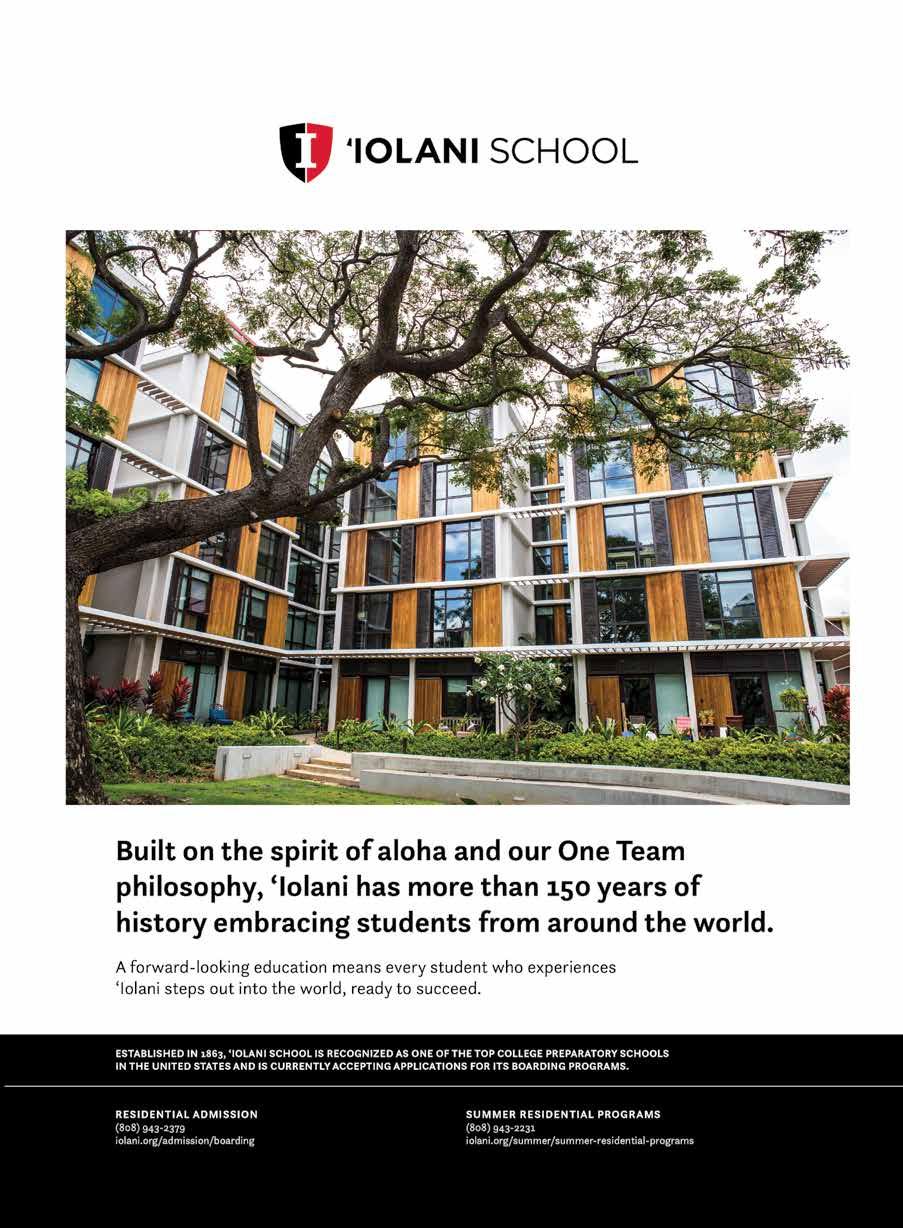

Together we create something that we wouldn’t have imagined on our own.
—Bobbi Jene Smith
Skydog Ranch and Sanctuary is a source of healing for horses and people alike.
From sunup to sundown, Clare Staples is hard at work, dedicating her days to the wellbeing of the Skydog Ranch and Sanctuary’s mustangs and burros. When in Malibu, she readies herself through morning meditation before fueling up on coffee and flying out the door for a day of feeding rounds, mucking stalls, mending fences, and all that accompanies maintaining its 11 acres.
“If you want to make God laugh, tell him your plans for the day,” is the saying Staples summons when asked about her daily routine. As founder of Skydog Ranch and Sanctuary, which has 9,000 acres of ranchland in Oregon and the Malibu sanctuary, she begins each day with an open mind, which is pertinent to the nonprofit’s success—and an intrinsic part of life on a ranch.
Rescued equines like Poppy and Moonshine are the source of that joy. After a harrowing journey crisscrossing states from Kansas to Oregon to Kentucky, the pair finally found their forever home with Skydog. Their formerly matted manes flow freely, and their coats gleam in the sunlight. Initially part of
a wild herd, they were removed from their land and corralled by the U.S. Bureau of Land Management, adopted, and then abandoned. Their story follows a pattern of purchase and abandon before finding their way into the open heart of the team at Skydog, which also brings rescues home from BLM pens.
“This is such a sustainable happiness, to see these incredible horses, to be able to dedicate myself to helping them come back to health and watch them live these beautiful lives,” says Staples. “There is such a deep joy in it.”
According to Staples, wild mustangs and burros are deemed a threat to more lucrative endeavors such as mining, agriculture, and livestock, and are rounded up and forced out of their home habitat. (The BLM frames this as the herds “[outgrowing] the ability of the land to support them.”)
“I found such a spiritual connection with horses,” Staples says. “They filled the void in my soul that I’d been filling with other things,” reflecting on a fast-paced, hard-partying past, with nights at clubs
Though days at Skydog Ranch and Sanctuary are challenging and often unpredictable, each day leaves its founder Clare Staples feeling fulfilled and grateful.



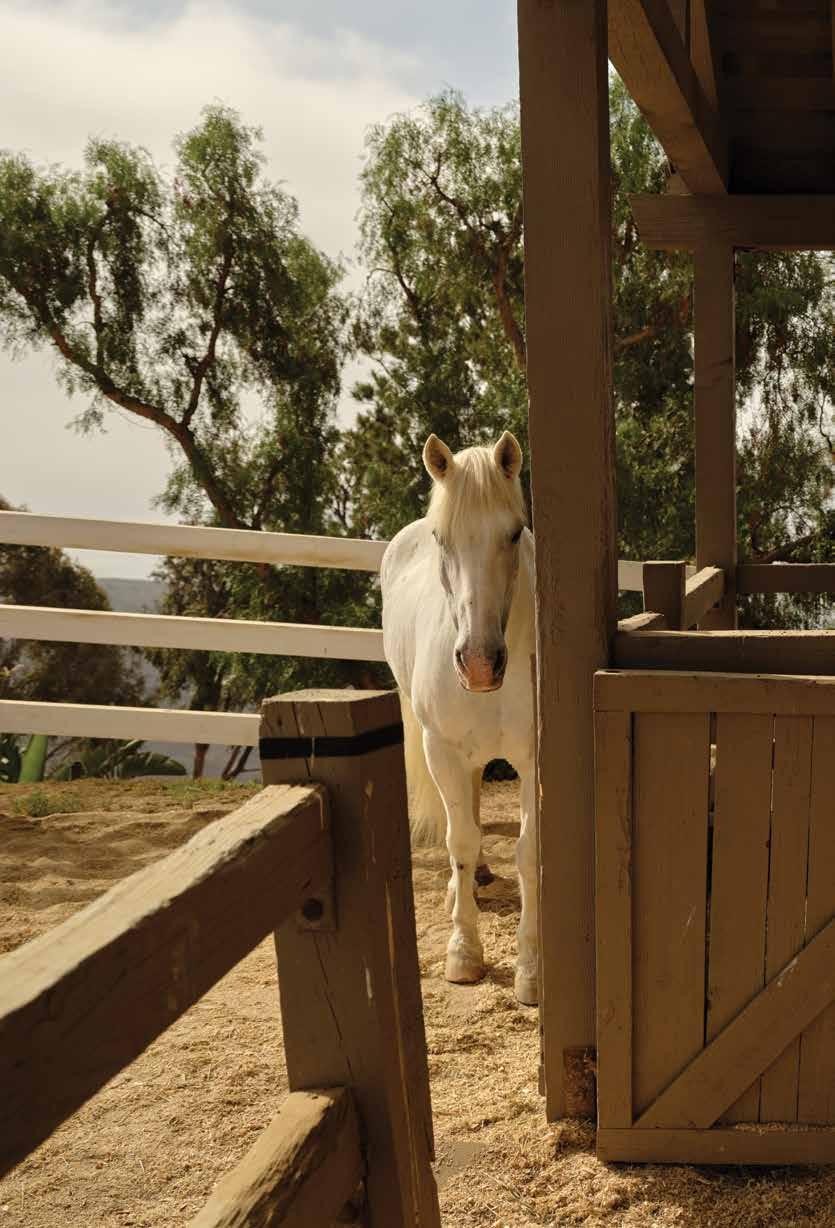

and private parties alongside Hollywood A-listers. “From the outside, I was living the dream life, traveling on private jets and yachts, hanging out with famous people. But it actually was really a very painful time.”
When her life began to unravel in a blur of addiction, materialism, and a tabloid-strewn divorce, Staples sought solace in riding. In the throes of early recovery, she encountered a strong, young horse, branding marks evident along his neck. She recognized in the animal something she also identified within herself—inherent strength. “I didn’t know a thing about ... what was happening to wild horses,” she says of their forced removal. “Buddy taught me all that.” Shortly after seeing the stallion, Staples adopted him from his rescuer.
Staples had found her calling, and Skydog Ranch and Sanctuary came to be. The ranch and sanctuary were launched through her own means, but volunteers keep the program thriving, pen-pal-ing with sponsors, sending postcards from the ranch, and doing deep dives into the background of each horse,
hoping to reunite four-legged families. The foundation also has an online rescue foster program. Gerard Butler, Darryl Hannah, Whitney Cummings, and Julianne Hough have all been generous supporters of the rescue’s mission, according to Staples. “Even just $5 makes me cry,” she says. “I think about the person who sent it sitting down, writing that check, putting it in the envelope, putting the stamp on it and taking it to the mailbox. That’s a huge sense of responsibility for me. That money was sent to help.”
Skydog is now home to 170 mustangs and 45 burros, but it has just as powerfully served as a place of salvation for Staples and others who look at the horses and burros and see their greater purpose. “The mustangs know on a very deep level what we’ve done for them,” says Staples. “Looking into their eyes and being able to have that connection ... it’s profound.”

Glass artist Joe Cariati and his close collaborators put community first, making singular objects while sharing space and knowledge.
Master glassblower Joe Cariati, who has since 2011 made his elegant glass forms in a 4,500-square-foot building just south of Los Angeles in the beachside town of El Segundo, recalls looking around and realizing, “I’ve got way too much space.” So he asked his team of three skilled glassblowers and his glassblowing friends, “What do we do?” They decided to open a community center to reach the public and bolster the city’s local glass community, sharing a complex art form to which the general public rarely has access. “Because everybody’s got to help their buddy,” as Cariati put it, especially in a world as small as the glassblowing one.
The Los Angeles Glass Center hosted its first workshop on June 15, 2019, inviting neighbors to come craft glass cups. For about 10 months, the center was magical. They offered demonstrations, workshops for first-time glassblowers, and appointments for more skilled craftspeople. They hosted a showcase of Black makers and an intergenerational women’s symposium. They held workshops by visiting master glassblowers and classes for youth. “When you see people blow glass
for the first time, they light up. It’s something they’ve never experienced,” says glass artist Austin Fields, Cariati’s life partner, who makes her sculptures out of the El Segundo studio. “Our collective goal was to bring glassblowing to everybody.”
Then in March 2020, as the Covid-19 virus began affecting cities worldwide, the center had to close its doors to the public. “Glass blowing is such a close proximity craft,” Cariati acknowledges with regret. “You have to blow on the flow pipe to teach, and hold people’s hands.”
But Cariati’s studio has, in many ways, always been driven by community and collaboration. He has an open-door policy, unusual for a studio producing work that requires such precision and skill. “There are studios, for example, that don’t allow any outsiders,” observes Fields, who moved to L.A. from Arlington, Texas two years ago. “They’ll say, ‘This is my studio. We’re only making my work.’ Joe has this harmonious balance of being a mentor and maker, and that vibe and attitude makes people feel welcome.”
“I have a very opendoor policy here in terms of just sharing knowledge,” says glass artist Joe Cariati. “I got to create the studio that I always wanted to work in.”


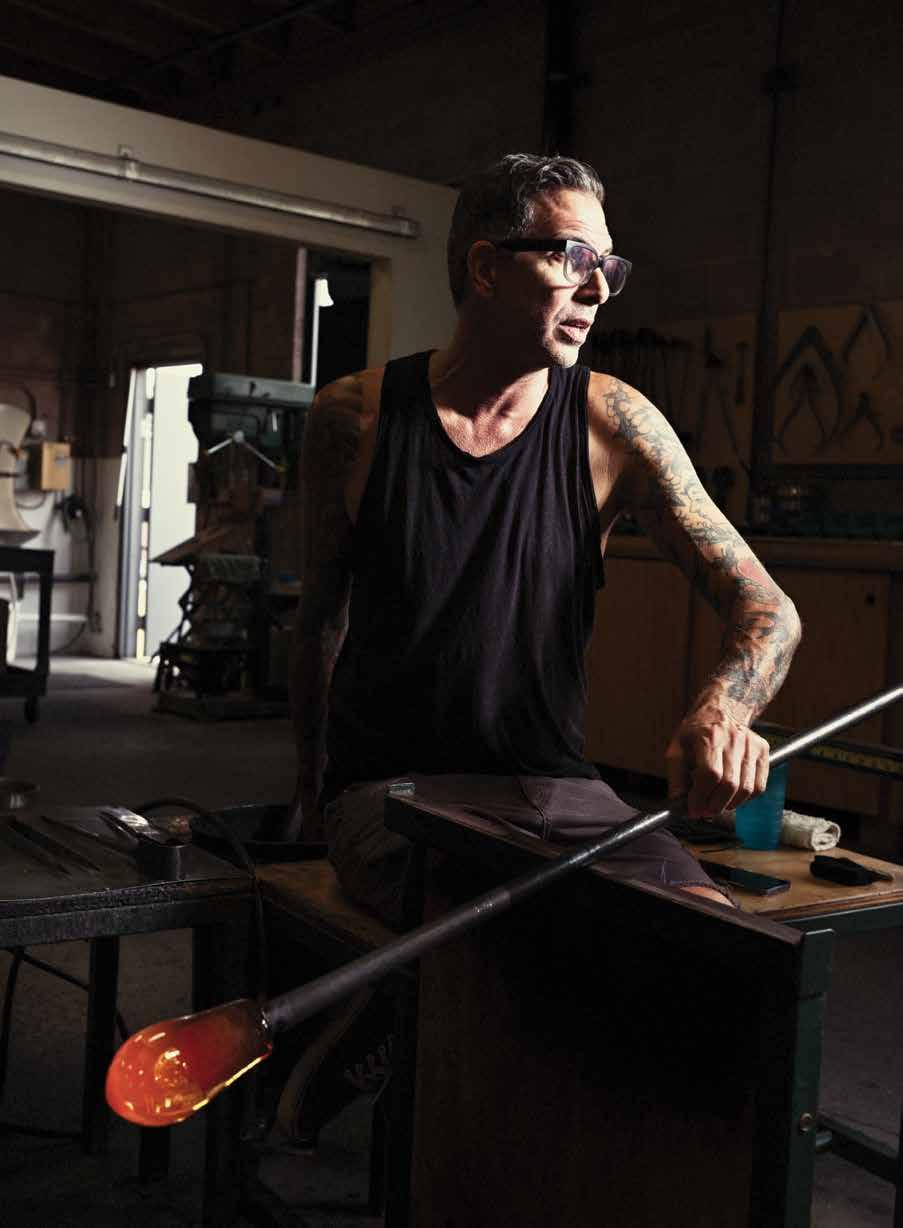
According to Fields, glassblowers from out of town email Cariati and say they’d love to make some work or come by and observe. This welcoming approach infects and inspires those who work in the space.
Cariati, who makes ethereal, strikingly minimal forms in the longstanding Venetian glassblowing tradition, is known for the precision of his process. No two vessels are the same, as each is made using an ancient free-blowing technique, but Cariati is able to replicate his personal process with such fidelity that his signature forms are nearly identical. His Angelic Vases and Venetian Decanters boast far fewer flourishes and none of the patterning that characterizes old-school Venetian pieces, and they are more delicate than the mid-century modern collections that inspire Cariati. Revered mid-20th century companies such as Blenko or Empoli used thicker glass, making their spire-topped decanters and vases from molds. “If you look at my work, it’s reduced from that stuff,” says Cariati, “but elevated and modernized to be something completely new.”
Since childhood, Cariati had enjoyed digging in the dirt, toying with motorcycles, and building things, but wasn’t sure he could make a career out of these inclinations.
When he stumbled upon glassblowing in the early 1990s, Cariati was a student at San Francisco State University. He enrolled in SFSU’s storied glassblowing course, and thrived, though he didn’t realize there was a future in it for him until his professor, glass artist John Leighton, told him that he “would have no problem making it” in the intimate world of glassblowing. After graduating, he worked in a handful of glassblowers’ studios in the San Francisco Bay Area and continued to study. But he traces his expertise in the Venetian tradition to the Pilchuck Glass School, founded in 1971 by maverick glass artist Dale Chihuly.
While Cariati has both studied and taught at Pilchuck over the years, most of the glassblowers he worked with had been there—so the school began influencing him long before he arrived. Originally, Pilchuck was a place for experimentation, where artists spurned the traditions that had for so long made glass an inflexible medium—or, in Cariati’s words, “it was a bunch of hippies who got together, built a furnace out of bricks, smoked a bunch of weed, got drunk, and made things.” Then in 1979, Chihuly invited Italian maestro Lino Tagliapietra to Pilchuck, interrupting the hippie energy and shifting U.S. glassblowing. Tagliapietra





used the same glass blowpipe techniques that Italian artisans had employed since the Renaissance, and his craft entranced Pilchuck artists. “When Lino came, the attitude of the glassblowers was, ‘Holy shit. We know nothing; Lino knows everything,’” recalls Cariati, who has studied with Tagliapietra himself but initially learned Venetian techniques from glassblowers who had been at Pilchuck during the 1970s and 1980s.
Cariati left the Bay Area for L.A. in 2003. A friend had opened a studio in El Segundo, just blocks from where Cariati now works, and Leighton had moved to University of California Fullerton and offered Cariati a teaching gig. It seemed an opportune time to work on what would become his self-titled line, which he officially launched in 2007. For it, he adjusted the techniques passed down by Tagliapietra, who was known for his painstakingly long process. “I didn’t care to make one thing that takes six to eighteen hours,” Cariati says. “I can’t do that in my personality, my lifestyle. What interests me is making a thousand things exactly the same in a repeated rapidfire succession.” His studio can make, on average, 20 objects per day. Yet nothing about them looks mass produced. They appear to be more air than glass, so thin and light you could watch an entire sunset through them and not miss a detail.
“They’re free blown. They’re made in space; they’re made at the bench. They’re made by hand,” he says. But their repeatability serves his ultimate goals: “I wanted to be in every single modern home on the globe.” He has been making progress on that front, his forms featured consistently during Modernism Week in Palm Springs and celebrated by interior designers including Michael Walters and Tamara Eaton.
Still, the community-building side of Cariati’s work has remained as important as the glassblowing itself. He has cared about teaching and mentorship from the start—an increasingly crucial mission as glassblowing
programs close across the country. SFSU’s glass course was dropped from the fine arts curriculum in 2002, and, in 2010, when Cariati’s adjunct position at Fullerton was cut for budget reasons, students raised funds to try to keep him on. There is a hunger for mentorship, especially in a field like this one, in which object-making requires equipment and multiple sets of hands.
So Cariati’s studio has become a launchpad for new projects. Fields is working on a collaboration with architect and designer Julia Koerner, in which Korner’s 3D-printed topographies become bases for abstracted glass forms. Artist Corey Pemberton, who helped set the L.A. Glass Center in motion and worked alongside Cariati, founded Crafting the Future, a nonprofit devoted to supporting makers of color and providing mentorship and education opportunities to young people, in 2019. Cedric Mitchell, who studied and then taught at the Tulsa Glassblowing School before joining Cariati’s studio in 2016, still works with Cariati three days a week and just launched his own line of glassware with Heath Ceramics. He also serves as the resources and opportunity manager for Crafting the Future. “The basis of it was to diversify the fields of craft art,” says Mitchell, whose role with the nonprofit involves seeking out mentorship and job opportunities for young makers. The first year, they raised over a quarter of a million dollars and were able to send 30 youth to school. During the pandemic, they’ve had to be more creative, pairing young people with master craftspeople for one-on-one mentorships.
Mitchell has found that teaching makes him a better artist. “If you can explain something to teach someone, it transmutes to your own working process,” he says. He adds that finding his voice as a glassblower will likely be a lifelong process. Cariati agrees, calling glassblowing “a practice akin to yoga,” he says. “You never reached the pinnacle.”

